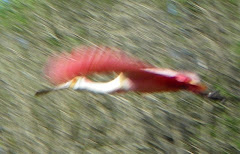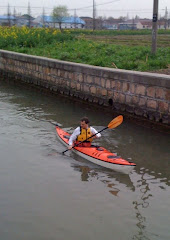 Over New Year I visited Brighton, where I grew up in England. Strolling the sea front I was reminded of my early kayaking. (The Royal Pavilion above is close to the beach)
Over New Year I visited Brighton, where I grew up in England. Strolling the sea front I was reminded of my early kayaking. (The Royal Pavilion above is close to the beach)

My first kayaking experience was on the oxbow lake at Cuckmere Haven, (east from Brighton) in a yellow canvas tandem, encouraged by my brother Michael. He later bought a partly finished wood-frame kayak, and re-skinned it. Anxious not to be left behind I scoured the classified ads in the local paper until I found a similar but already seaworthy kayak; a PBK11.
 I can't imagine how I survived my first winter of paddling; my clothing was woefully inadequate for multiple immersions in the knee-deep surf zone as my kayak flipped following almost every ride. Dragging my kayak up the lumpy flint beach by West Pier, I'd retreat shivering to the damp cave of my friend's family fishing space under the seafront promenade to change from my drenched cotton t-shirt and running shorts. Coffee water heated on the tiny stove in a tin kettle that on one occasion yielded a boiled mouse...
I can't imagine how I survived my first winter of paddling; my clothing was woefully inadequate for multiple immersions in the knee-deep surf zone as my kayak flipped following almost every ride. Dragging my kayak up the lumpy flint beach by West Pier, I'd retreat shivering to the damp cave of my friend's family fishing space under the seafront promenade to change from my drenched cotton t-shirt and running shorts. Coffee water heated on the tiny stove in a tin kettle that on one occasion yielded a boiled mouse...
 My friends and I upgraded our kayaks after joining Brighton Canoe Club, with its storage facility "under the arches" near Palace Pier. I bought a used red KW3 and fiber-glassed wooden thigh braces into the cockpit for a tighter fit. Mimicking the tricks of Graham Goldsmith, we "beach-looped" our kayaks in the steep dumping waves, and later left sticky polyester resin pools and salt-damp fiberglass matting on the club-house furniture.
My friends and I upgraded our kayaks after joining Brighton Canoe Club, with its storage facility "under the arches" near Palace Pier. I bought a used red KW3 and fiber-glassed wooden thigh braces into the cockpit for a tighter fit. Mimicking the tricks of Graham Goldsmith, we "beach-looped" our kayaks in the steep dumping waves, and later left sticky polyester resin pools and salt-damp fiberglass matting on the club-house furniture. 
One of the club members "borrowed" a newly built KW3 from the storage rack to join us one day. The boat was not yet completely finished; no foot-braces or flotation. Standing the kayak on end in the dumpers, he slid right down into the cockpit and broke the bow off the kayak. With his trapped feet sticking out from the broken end and the kayak quickly sinking, I think he was lucky to be dragged from the surf alive!
A few miles along the coast at Shoreham was the Streamlight Mouldings workshop producing Keith White's "KW" kayaks. (my second kayak was a used red KW3, then an old slalom model) Closer to home the Goldsmith brothers Graham and Bob started up business as Gaybo Ltd with their first two models; "Mini-slalom" and "Funa" in the bare-wood attic space above a car body-work workshop in Brighton. (My third kayak was a blue Funa... the one shown in the photos above, taken by my dad).
Touring "home territory" at the start of 2009 I dropped in on "Brighton Canoes", ironically in the nearby coastal town Newhaven. While storekeeper Luke was busy attending a family who had just purchased sit-on-top kayaks, I checked out the Point65 kayaks in the racks.

Later we strolled through the town of Lewes. This historic town sits beside the River Ouse. Standing guard over the town is a flint-walled castle built after the Norman conquest in 1066 on the site of an earlier Saxon castle. The town boasts many interesting historical connections... for example a priory founded in 1078, and the more recent Anne of Cleves' House. Keeping her head, Anne received the property as part of her divorce settlement from King Henry 8th. This timber-framed thatched hall is now a museum.
The Lewes bonfire and fireworks celebrations on Guy Fawkes night (November 5th) each year commemorate not only the uncovering of the Catholic plot to blow up the Houses of Parliament in 1605, (including King James 1st with both theHouse of Commons and the Lords) but also the burning at stake in the Lewes high Street of 17 Protestant martyrs in Lewes during the persecution of Protestants by Queen "Bloody" Mary between 1555-1557. As part of the celebration 17 burning crosses are carried through town in memory of the Lewes martyrs. Effigies of Guy Fawkes and of Pope Paul 5th (head of the Roman Catholic church in 1605) are also paraded before being thrown on the fires.

The River Ouse is just one of several rivers that rise in the clay and sandstone Weald to the north, cutting through the chalk Downs to the English Channel coast. The River Cuckmere is another. On 2nd January Kristin and I revisited the Cuckmere. Sharing a canoe with Kristin, I paddled alongside my sister Debbie who had brought down the canoes and teamed with Kim, while David whirled around us in his whitewater kayak. We launched onto the Oxbow Lake near the mouth, and carried over the levee into the river by Exceat Bridge onto a rising tide, that would carry us up a meandering route constrained now by levees topped by public footpaths.


The white horse carved into the side of Hindover Hill, exposing the white chalk rock beneath, is quite recent. Apparently it was cut overnight in 1924 by three men working under a full moon. The Long Man of Wilmington further up the Cuckmere Valley on Windover Hill is much older, possibly dating back to neolithic times.


We passed Alfriston, one of several ancient villages in the river valley. Alfriston's 14th century flint church predates the nearby Star Inn , 1520, which is an interesting place to stop for a pint and a ploughman's lunch. Beyond Alfriston, near Milton Street at the tidal sluice, we paused for lunch and to wait for the tide to turn before scurrying back through the short afternoon.

Before returning to Seattle we heard the Everest summit man Cliff was having a birthday gathering in Lewes, so we dropped in on him at the White Hart to wish him "many happy returns". Appropriately enough, we supped a "pint of Harvey's bitter", brewed down the road by the river Ouse, and long a favorite of mine. Turned out the barman was a kayaker... and used to work at Brighton Canoes...
































